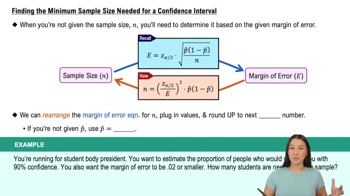Table of contents
- 1. Intro to Stats and Collecting Data55m
- 2. Describing Data with Tables and Graphs1h 55m
- 3. Describing Data Numerically1h 45m
- 4. Probability2h 16m
- 5. Binomial Distribution & Discrete Random Variables2h 33m
- 6. Normal Distribution and Continuous Random Variables1h 38m
- 7. Sampling Distributions & Confidence Intervals: Mean1h 3m
- 8. Sampling Distributions & Confidence Intervals: Proportion1h 12m
- 9. Hypothesis Testing for One Sample1h 1m
- 10. Hypothesis Testing for Two Samples2h 8m
- 11. Correlation48m
- 12. Regression1h 4m
- 13. Chi-Square Tests & Goodness of Fit1h 20m
- 14. ANOVA1h 0m
6. Normal Distribution and Continuous Random Variables
Standard Normal Distribution
Problem 2.CQQ.10d
Textbook Question
Normal Distribution If the following data are randomly selected, which are expected to have a normal distribution?
d. Exact volumes of Coke in 12 oz cans
 Verified step by step guidance
Verified step by step guidance1
Understand the concept of a normal distribution: A normal distribution is a bell-shaped curve that is symmetric about the mean. It is characterized by most data points clustering around the mean, with fewer data points appearing as you move further away from the mean in either direction.
Consider the context of the problem: The exact volumes of Coke in 12 oz cans are being analyzed. Manufacturing processes, such as filling cans, are typically designed to produce consistent results, which often follow a normal distribution due to random variations around a target value.
Evaluate the factors that could influence the distribution: If the filling process is well-controlled and the variations are random and small, the data is likely to follow a normal distribution. However, if there are systematic errors or large deviations, the distribution may not be normal.
Check for empirical evidence: To confirm whether the data follows a normal distribution, you could collect a sample of the exact volumes of Coke in 12 oz cans and perform a normality test, such as the Shapiro-Wilk test or the Kolmogorov-Smirnov test.
Visualize the data: Plot a histogram or a Q-Q plot of the sample data. A bell-shaped histogram or a Q-Q plot where the points lie close to the diagonal line would suggest that the data is approximately normally distributed.
 Verified video answer for a similar problem:
Verified video answer for a similar problem:This video solution was recommended by our tutors as helpful for the problem above
Video duration:
3mPlay a video:
Was this helpful?
Key Concepts
Here are the essential concepts you must grasp in order to answer the question correctly.
Normal Distribution
Normal distribution is a probability distribution that is symmetric about the mean, showing that data near the mean are more frequent in occurrence than data far from the mean. It is characterized by its bell-shaped curve, defined by its mean and standard deviation. Many natural phenomena, such as heights or test scores, tend to follow this distribution, making it a fundamental concept in statistics.
Recommended video:
Guided course

Finding Standard Normal Probabilities using z-Table
Central Limit Theorem
The Central Limit Theorem states that the distribution of the sample means will approach a normal distribution as the sample size increases, regardless of the shape of the population distribution. This theorem is crucial for making inferences about population parameters based on sample statistics, especially when dealing with large samples, as it justifies the use of normal distribution in various statistical analyses.
Recommended video:
Guided course

Calculating the Mean
Measurement Error
Measurement error refers to the difference between the actual value and the value obtained through measurement. In the context of the exact volumes of Coke in 12 oz cans, slight variations in filling processes can lead to a distribution of volumes that approximates normality due to the aggregation of these small errors. Understanding measurement error is essential for interpreting data accurately and assessing the reliability of statistical conclusions.
Recommended video:

Finding the Minimum Sample Size Needed for a Confidence Interval

 9:47m
9:47mWatch next
Master Finding Standard Normal Probabilities using z-Table with a bite sized video explanation from Patrick
Start learning


